Leadership and Management Roles and Functions at Tesco Report
VerifiedAdded on 2020/10/05
|18
|5756
|410
Report
AI Summary
This report provides a comprehensive analysis of leadership and management practices within Tesco, a leading UK supermarket chain. It begins by differentiating between the roles and characteristics of leaders and managers, highlighting their similarities and differences, and emphasizing their importance in achieving organizational goals. The report then delves into the functions of a manager, as outlined by Fayol's model, including planning, organizing, commanding, coordinating, and controlling. Furthermore, it explores various leadership theories such as situational leadership, system leadership, and contingency leadership, evaluating their applicability within Tesco. The report also discusses the importance of operations management and its impact on decision-making, offering insights into how Tesco utilizes these concepts to optimize its business activities and achieve its objectives. Overall, the report provides a detailed overview of leadership and management strategies within Tesco, supported by relevant theories and models.
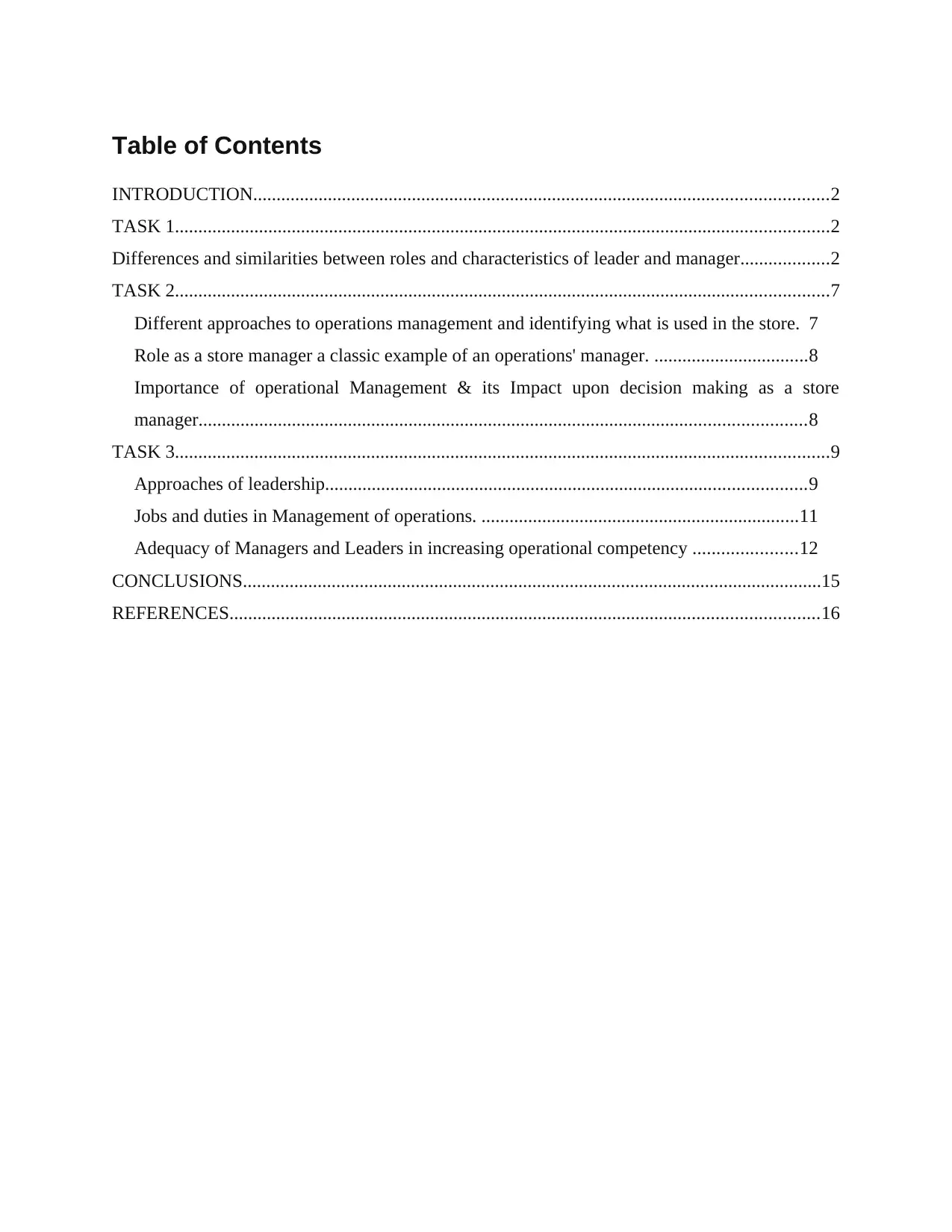
Table of Contents
INTRODUCTION...........................................................................................................................2
TASK 1............................................................................................................................................2
Differences and similarities between roles and characteristics of leader and manager...................2
TASK 2............................................................................................................................................7
Different approaches to operations management and identifying what is used in the store. 7
Role as a store manager a classic example of an operations' manager. .................................8
Importance of operational Management & its Impact upon decision making as a store
manager..................................................................................................................................8
TASK 3............................................................................................................................................9
Approaches of leadership.......................................................................................................9
Jobs and duties in Management of operations. ....................................................................11
Adequacy of Managers and Leaders in increasing operational competency ......................12
CONCLUSIONS............................................................................................................................15
REFERENCES..............................................................................................................................16
INTRODUCTION...........................................................................................................................2
TASK 1............................................................................................................................................2
Differences and similarities between roles and characteristics of leader and manager...................2
TASK 2............................................................................................................................................7
Different approaches to operations management and identifying what is used in the store. 7
Role as a store manager a classic example of an operations' manager. .................................8
Importance of operational Management & its Impact upon decision making as a store
manager..................................................................................................................................8
TASK 3............................................................................................................................................9
Approaches of leadership.......................................................................................................9
Jobs and duties in Management of operations. ....................................................................11
Adequacy of Managers and Leaders in increasing operational competency ......................12
CONCLUSIONS............................................................................................................................15
REFERENCES..............................................................................................................................16
Paraphrase This Document
Need a fresh take? Get an instant paraphrase of this document with our AI Paraphraser
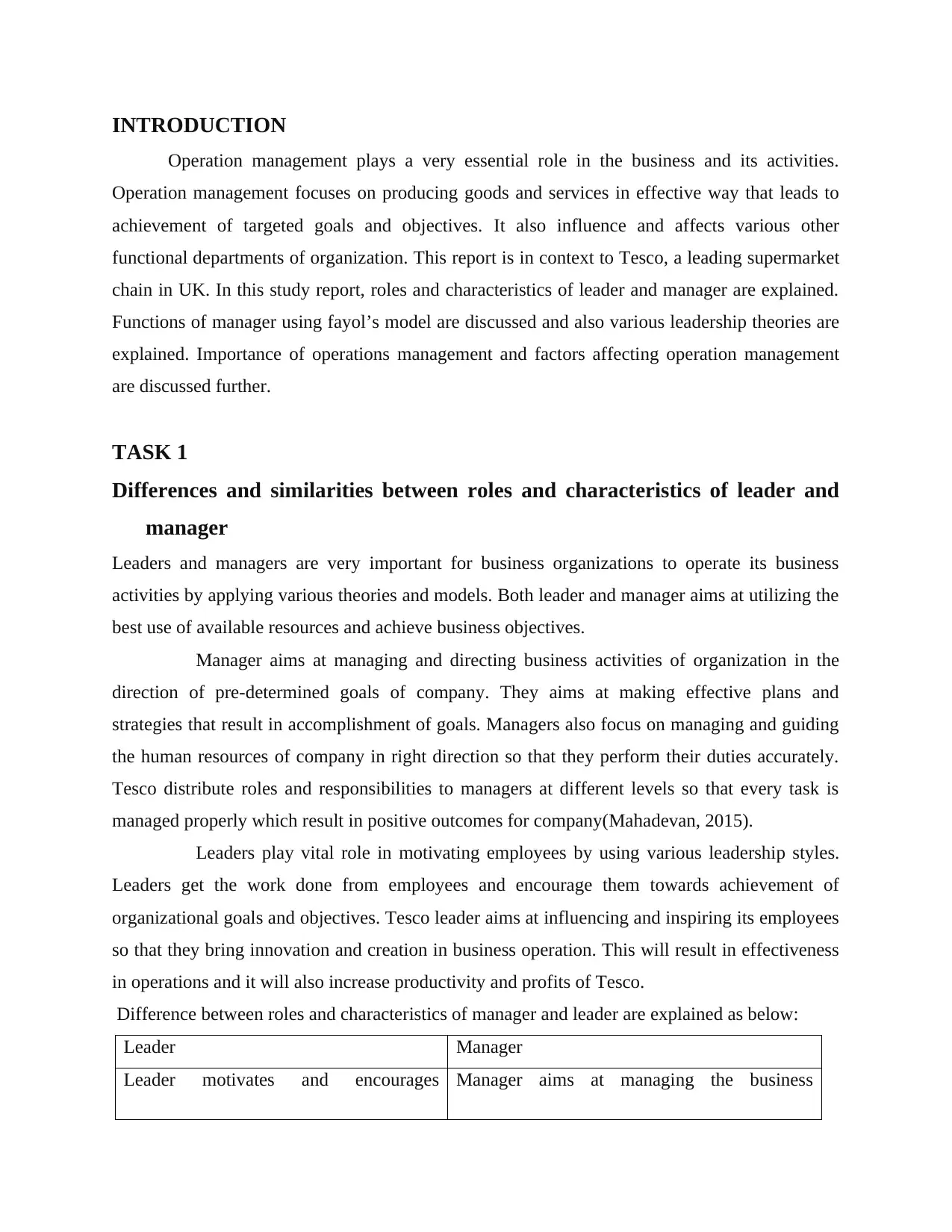
INTRODUCTION
Operation management plays a very essential role in the business and its activities.
Operation management focuses on producing goods and services in effective way that leads to
achievement of targeted goals and objectives. It also influence and affects various other
functional departments of organization. This report is in context to Tesco, a leading supermarket
chain in UK. In this study report, roles and characteristics of leader and manager are explained.
Functions of manager using fayol’s model are discussed and also various leadership theories are
explained. Importance of operations management and factors affecting operation management
are discussed further.
TASK 1
Differences and similarities between roles and characteristics of leader and
manager
Leaders and managers are very important for business organizations to operate its business
activities by applying various theories and models. Both leader and manager aims at utilizing the
best use of available resources and achieve business objectives.
Manager aims at managing and directing business activities of organization in the
direction of pre-determined goals of company. They aims at making effective plans and
strategies that result in accomplishment of goals. Managers also focus on managing and guiding
the human resources of company in right direction so that they perform their duties accurately.
Tesco distribute roles and responsibilities to managers at different levels so that every task is
managed properly which result in positive outcomes for company(Mahadevan, 2015).
Leaders play vital role in motivating employees by using various leadership styles.
Leaders get the work done from employees and encourage them towards achievement of
organizational goals and objectives. Tesco leader aims at influencing and inspiring its employees
so that they bring innovation and creation in business operation. This will result in effectiveness
in operations and it will also increase productivity and profits of Tesco.
Difference between roles and characteristics of manager and leader are explained as below:
Leader Manager
Leader motivates and encourages Manager aims at managing the business
Operation management plays a very essential role in the business and its activities.
Operation management focuses on producing goods and services in effective way that leads to
achievement of targeted goals and objectives. It also influence and affects various other
functional departments of organization. This report is in context to Tesco, a leading supermarket
chain in UK. In this study report, roles and characteristics of leader and manager are explained.
Functions of manager using fayol’s model are discussed and also various leadership theories are
explained. Importance of operations management and factors affecting operation management
are discussed further.
TASK 1
Differences and similarities between roles and characteristics of leader and
manager
Leaders and managers are very important for business organizations to operate its business
activities by applying various theories and models. Both leader and manager aims at utilizing the
best use of available resources and achieve business objectives.
Manager aims at managing and directing business activities of organization in the
direction of pre-determined goals of company. They aims at making effective plans and
strategies that result in accomplishment of goals. Managers also focus on managing and guiding
the human resources of company in right direction so that they perform their duties accurately.
Tesco distribute roles and responsibilities to managers at different levels so that every task is
managed properly which result in positive outcomes for company(Mahadevan, 2015).
Leaders play vital role in motivating employees by using various leadership styles.
Leaders get the work done from employees and encourage them towards achievement of
organizational goals and objectives. Tesco leader aims at influencing and inspiring its employees
so that they bring innovation and creation in business operation. This will result in effectiveness
in operations and it will also increase productivity and profits of Tesco.
Difference between roles and characteristics of manager and leader are explained as below:
Leader Manager
Leader motivates and encourages Manager aims at managing the business
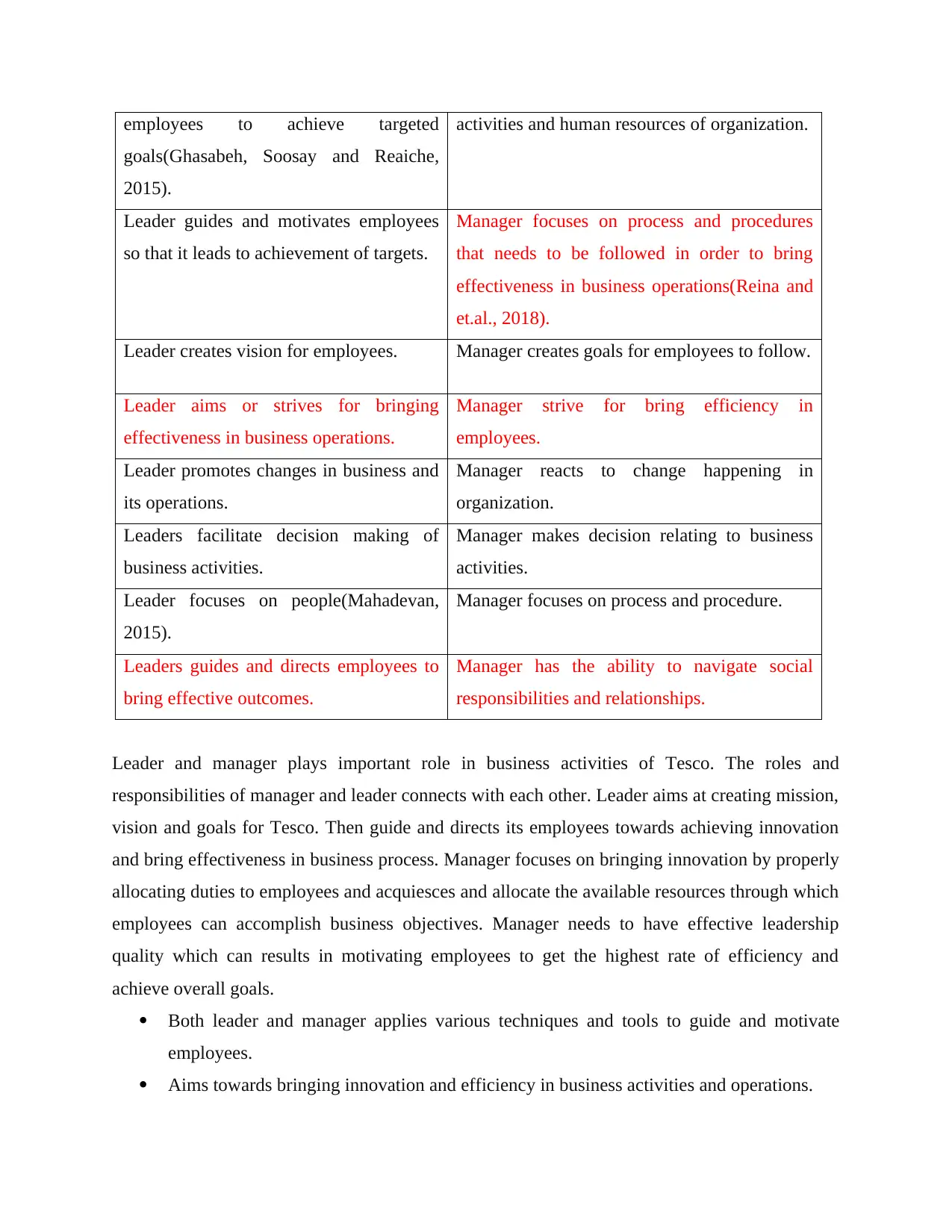
employees to achieve targeted
goals(Ghasabeh, Soosay and Reaiche,
2015).
activities and human resources of organization.
Leader guides and motivates employees
so that it leads to achievement of targets.
Manager focuses on process and procedures
that needs to be followed in order to bring
effectiveness in business operations(Reina and
et.al., 2018).
Leader creates vision for employees. Manager creates goals for employees to follow.
Leader aims or strives for bringing
effectiveness in business operations.
Manager strive for bring efficiency in
employees.
Leader promotes changes in business and
its operations.
Manager reacts to change happening in
organization.
Leaders facilitate decision making of
business activities.
Manager makes decision relating to business
activities.
Leader focuses on people(Mahadevan,
2015).
Manager focuses on process and procedure.
Leaders guides and directs employees to
bring effective outcomes.
Manager has the ability to navigate social
responsibilities and relationships.
Leader and manager plays important role in business activities of Tesco. The roles and
responsibilities of manager and leader connects with each other. Leader aims at creating mission,
vision and goals for Tesco. Then guide and directs its employees towards achieving innovation
and bring effectiveness in business process. Manager focuses on bringing innovation by properly
allocating duties to employees and acquiesces and allocate the available resources through which
employees can accomplish business objectives. Manager needs to have effective leadership
quality which can results in motivating employees to get the highest rate of efficiency and
achieve overall goals.
Both leader and manager applies various techniques and tools to guide and motivate
employees.
Aims towards bringing innovation and efficiency in business activities and operations.
goals(Ghasabeh, Soosay and Reaiche,
2015).
activities and human resources of organization.
Leader guides and motivates employees
so that it leads to achievement of targets.
Manager focuses on process and procedures
that needs to be followed in order to bring
effectiveness in business operations(Reina and
et.al., 2018).
Leader creates vision for employees. Manager creates goals for employees to follow.
Leader aims or strives for bringing
effectiveness in business operations.
Manager strive for bring efficiency in
employees.
Leader promotes changes in business and
its operations.
Manager reacts to change happening in
organization.
Leaders facilitate decision making of
business activities.
Manager makes decision relating to business
activities.
Leader focuses on people(Mahadevan,
2015).
Manager focuses on process and procedure.
Leaders guides and directs employees to
bring effective outcomes.
Manager has the ability to navigate social
responsibilities and relationships.
Leader and manager plays important role in business activities of Tesco. The roles and
responsibilities of manager and leader connects with each other. Leader aims at creating mission,
vision and goals for Tesco. Then guide and directs its employees towards achieving innovation
and bring effectiveness in business process. Manager focuses on bringing innovation by properly
allocating duties to employees and acquiesces and allocate the available resources through which
employees can accomplish business objectives. Manager needs to have effective leadership
quality which can results in motivating employees to get the highest rate of efficiency and
achieve overall goals.
Both leader and manager applies various techniques and tools to guide and motivate
employees.
Aims towards bringing innovation and efficiency in business activities and operations.
⊘ This is a preview!⊘
Do you want full access?
Subscribe today to unlock all pages.

Trusted by 1+ million students worldwide
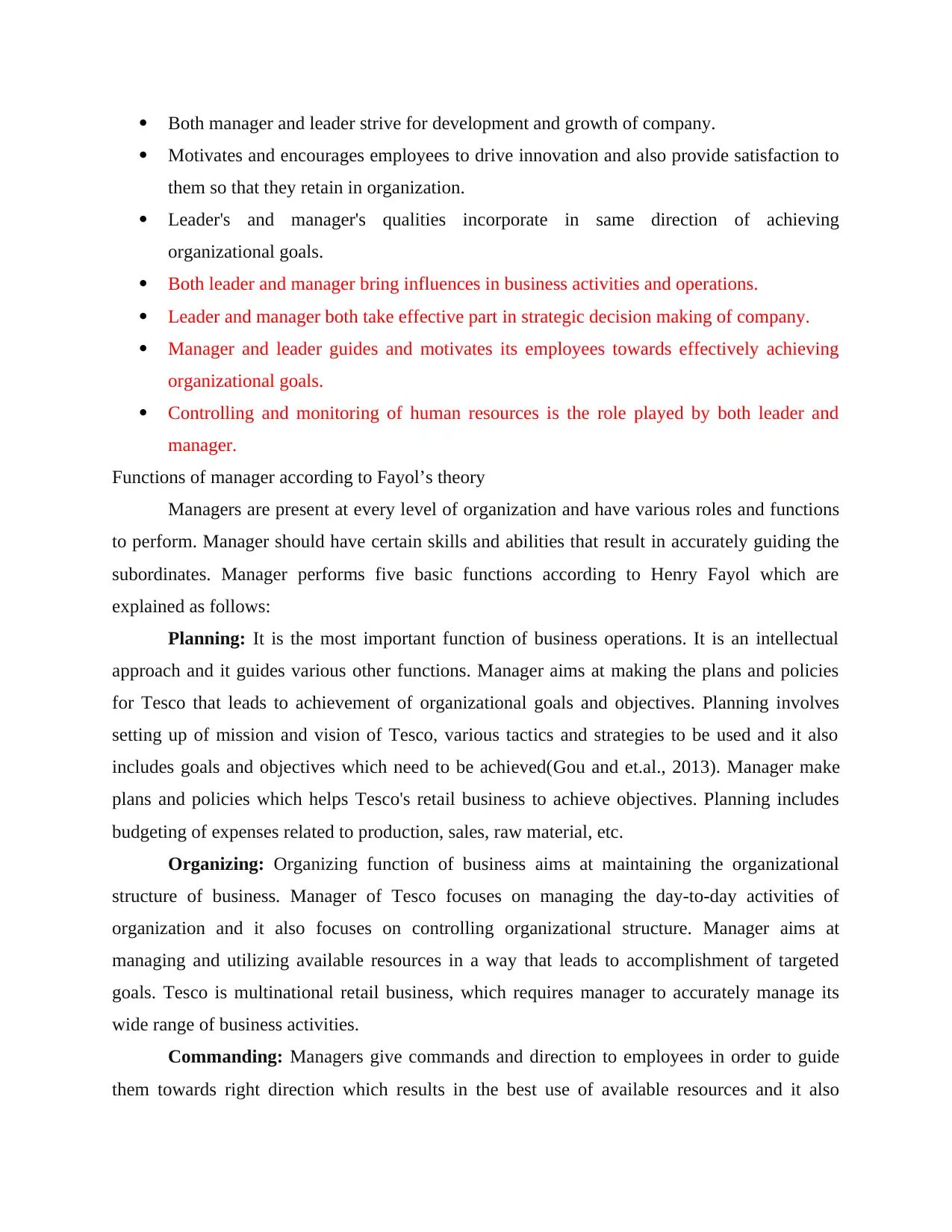
Both manager and leader strive for development and growth of company.
Motivates and encourages employees to drive innovation and also provide satisfaction to
them so that they retain in organization.
Leader's and manager's qualities incorporate in same direction of achieving
organizational goals.
Both leader and manager bring influences in business activities and operations.
Leader and manager both take effective part in strategic decision making of company.
Manager and leader guides and motivates its employees towards effectively achieving
organizational goals.
Controlling and monitoring of human resources is the role played by both leader and
manager.
Functions of manager according to Fayol’s theory
Managers are present at every level of organization and have various roles and functions
to perform. Manager should have certain skills and abilities that result in accurately guiding the
subordinates. Manager performs five basic functions according to Henry Fayol which are
explained as follows:
Planning: It is the most important function of business operations. It is an intellectual
approach and it guides various other functions. Manager aims at making the plans and policies
for Tesco that leads to achievement of organizational goals and objectives. Planning involves
setting up of mission and vision of Tesco, various tactics and strategies to be used and it also
includes goals and objectives which need to be achieved(Gou and et.al., 2013). Manager make
plans and policies which helps Tesco's retail business to achieve objectives. Planning includes
budgeting of expenses related to production, sales, raw material, etc.
Organizing: Organizing function of business aims at maintaining the organizational
structure of business. Manager of Tesco focuses on managing the day-to-day activities of
organization and it also focuses on controlling organizational structure. Manager aims at
managing and utilizing available resources in a way that leads to accomplishment of targeted
goals. Tesco is multinational retail business, which requires manager to accurately manage its
wide range of business activities.
Commanding: Managers give commands and direction to employees in order to guide
them towards right direction which results in the best use of available resources and it also
Motivates and encourages employees to drive innovation and also provide satisfaction to
them so that they retain in organization.
Leader's and manager's qualities incorporate in same direction of achieving
organizational goals.
Both leader and manager bring influences in business activities and operations.
Leader and manager both take effective part in strategic decision making of company.
Manager and leader guides and motivates its employees towards effectively achieving
organizational goals.
Controlling and monitoring of human resources is the role played by both leader and
manager.
Functions of manager according to Fayol’s theory
Managers are present at every level of organization and have various roles and functions
to perform. Manager should have certain skills and abilities that result in accurately guiding the
subordinates. Manager performs five basic functions according to Henry Fayol which are
explained as follows:
Planning: It is the most important function of business operations. It is an intellectual
approach and it guides various other functions. Manager aims at making the plans and policies
for Tesco that leads to achievement of organizational goals and objectives. Planning involves
setting up of mission and vision of Tesco, various tactics and strategies to be used and it also
includes goals and objectives which need to be achieved(Gou and et.al., 2013). Manager make
plans and policies which helps Tesco's retail business to achieve objectives. Planning includes
budgeting of expenses related to production, sales, raw material, etc.
Organizing: Organizing function of business aims at maintaining the organizational
structure of business. Manager of Tesco focuses on managing the day-to-day activities of
organization and it also focuses on controlling organizational structure. Manager aims at
managing and utilizing available resources in a way that leads to accomplishment of targeted
goals. Tesco is multinational retail business, which requires manager to accurately manage its
wide range of business activities.
Commanding: Managers give commands and direction to employees in order to guide
them towards right direction which results in the best use of available resources and it also
Paraphrase This Document
Need a fresh take? Get an instant paraphrase of this document with our AI Paraphraser
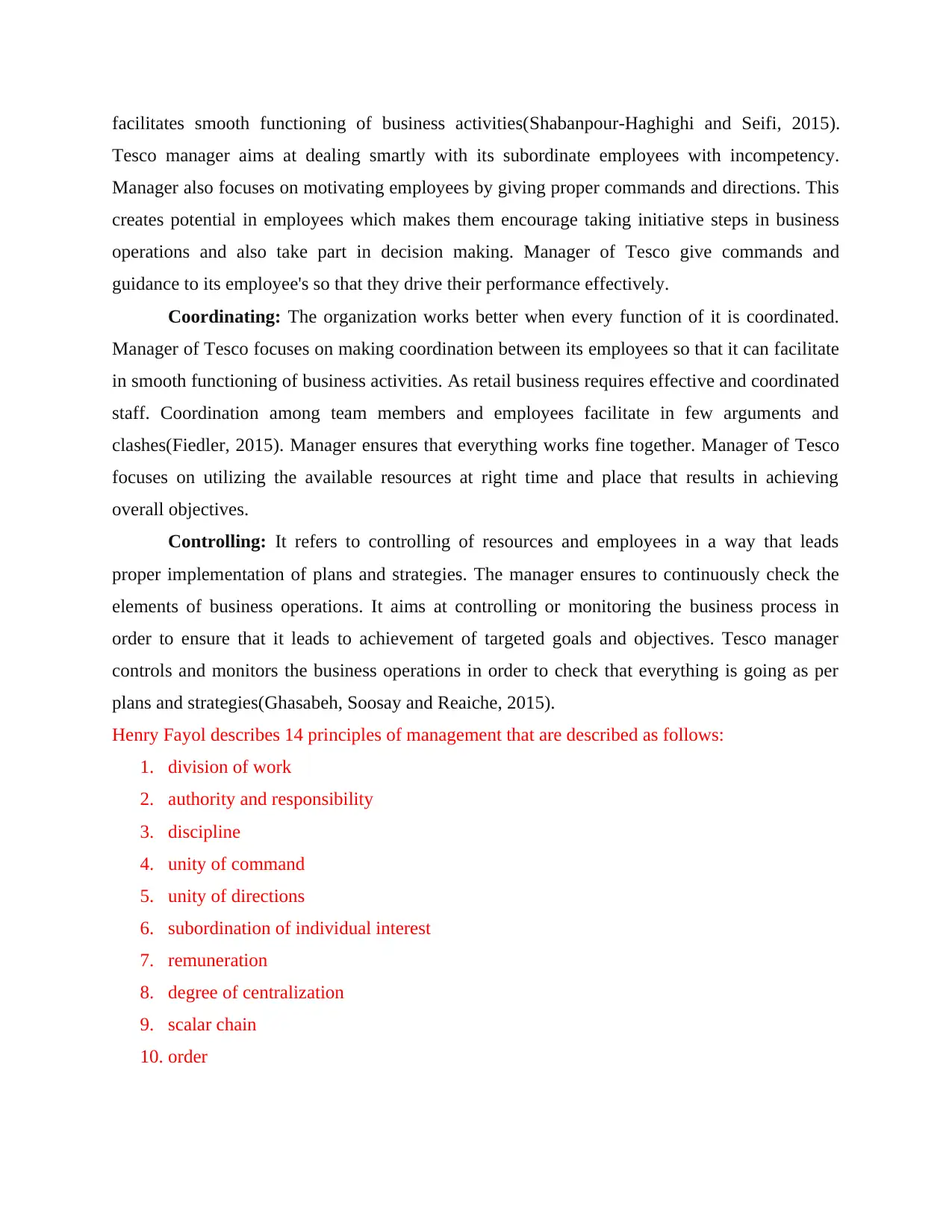
facilitates smooth functioning of business activities(Shabanpour-Haghighi and Seifi, 2015).
Tesco manager aims at dealing smartly with its subordinate employees with incompetency.
Manager also focuses on motivating employees by giving proper commands and directions. This
creates potential in employees which makes them encourage taking initiative steps in business
operations and also take part in decision making. Manager of Tesco give commands and
guidance to its employee's so that they drive their performance effectively.
Coordinating: The organization works better when every function of it is coordinated.
Manager of Tesco focuses on making coordination between its employees so that it can facilitate
in smooth functioning of business activities. As retail business requires effective and coordinated
staff. Coordination among team members and employees facilitate in few arguments and
clashes(Fiedler, 2015). Manager ensures that everything works fine together. Manager of Tesco
focuses on utilizing the available resources at right time and place that results in achieving
overall objectives.
Controlling: It refers to controlling of resources and employees in a way that leads
proper implementation of plans and strategies. The manager ensures to continuously check the
elements of business operations. It aims at controlling or monitoring the business process in
order to ensure that it leads to achievement of targeted goals and objectives. Tesco manager
controls and monitors the business operations in order to check that everything is going as per
plans and strategies(Ghasabeh, Soosay and Reaiche, 2015).
Henry Fayol describes 14 principles of management that are described as follows:
1. division of work
2. authority and responsibility
3. discipline
4. unity of command
5. unity of directions
6. subordination of individual interest
7. remuneration
8. degree of centralization
9. scalar chain
10. order
Tesco manager aims at dealing smartly with its subordinate employees with incompetency.
Manager also focuses on motivating employees by giving proper commands and directions. This
creates potential in employees which makes them encourage taking initiative steps in business
operations and also take part in decision making. Manager of Tesco give commands and
guidance to its employee's so that they drive their performance effectively.
Coordinating: The organization works better when every function of it is coordinated.
Manager of Tesco focuses on making coordination between its employees so that it can facilitate
in smooth functioning of business activities. As retail business requires effective and coordinated
staff. Coordination among team members and employees facilitate in few arguments and
clashes(Fiedler, 2015). Manager ensures that everything works fine together. Manager of Tesco
focuses on utilizing the available resources at right time and place that results in achieving
overall objectives.
Controlling: It refers to controlling of resources and employees in a way that leads
proper implementation of plans and strategies. The manager ensures to continuously check the
elements of business operations. It aims at controlling or monitoring the business process in
order to ensure that it leads to achievement of targeted goals and objectives. Tesco manager
controls and monitors the business operations in order to check that everything is going as per
plans and strategies(Ghasabeh, Soosay and Reaiche, 2015).
Henry Fayol describes 14 principles of management that are described as follows:
1. division of work
2. authority and responsibility
3. discipline
4. unity of command
5. unity of directions
6. subordination of individual interest
7. remuneration
8. degree of centralization
9. scalar chain
10. order
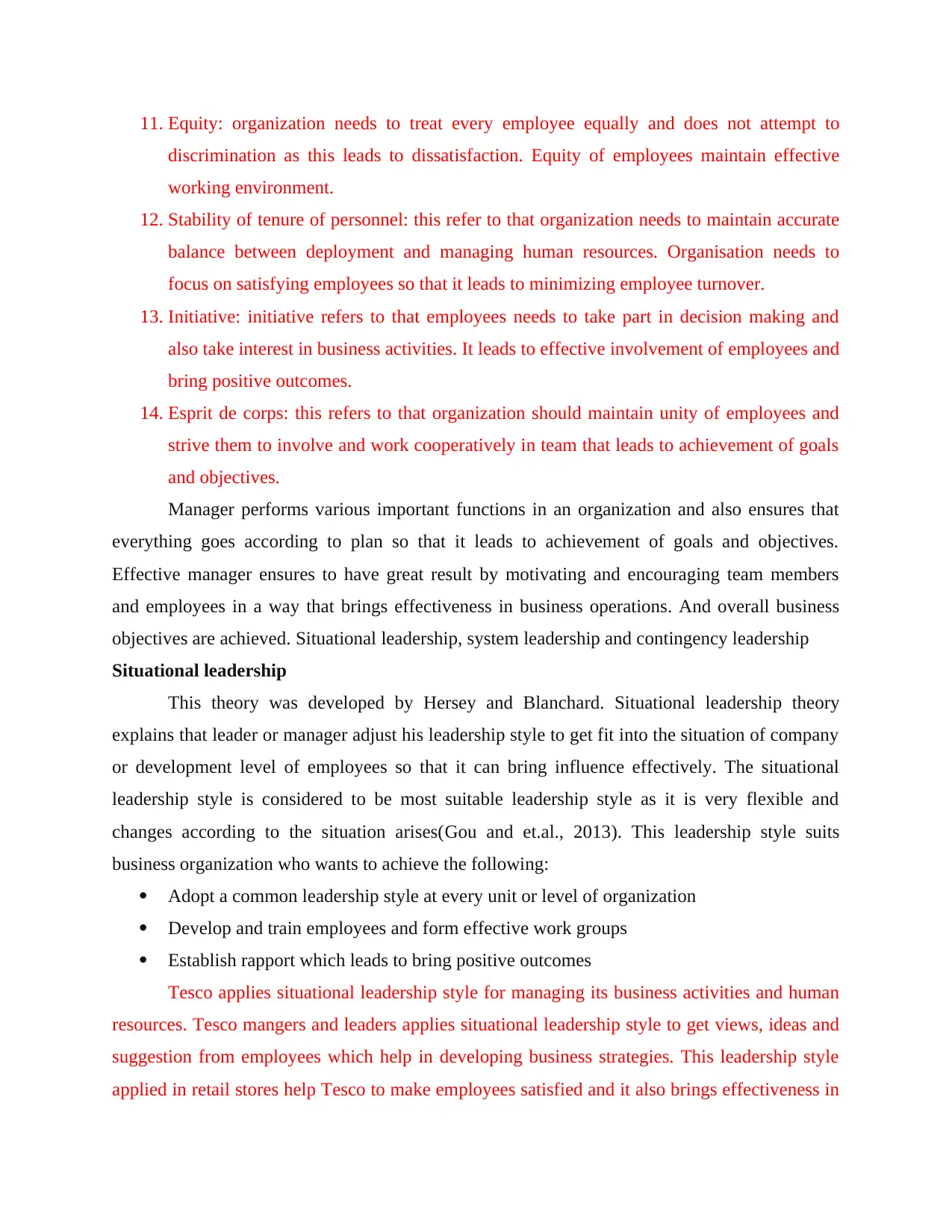
11. Equity: organization needs to treat every employee equally and does not attempt to
discrimination as this leads to dissatisfaction. Equity of employees maintain effective
working environment.
12. Stability of tenure of personnel: this refer to that organization needs to maintain accurate
balance between deployment and managing human resources. Organisation needs to
focus on satisfying employees so that it leads to minimizing employee turnover.
13. Initiative: initiative refers to that employees needs to take part in decision making and
also take interest in business activities. It leads to effective involvement of employees and
bring positive outcomes.
14. Esprit de corps: this refers to that organization should maintain unity of employees and
strive them to involve and work cooperatively in team that leads to achievement of goals
and objectives.
Manager performs various important functions in an organization and also ensures that
everything goes according to plan so that it leads to achievement of goals and objectives.
Effective manager ensures to have great result by motivating and encouraging team members
and employees in a way that brings effectiveness in business operations. And overall business
objectives are achieved. Situational leadership, system leadership and contingency leadership
Situational leadership
This theory was developed by Hersey and Blanchard. Situational leadership theory
explains that leader or manager adjust his leadership style to get fit into the situation of company
or development level of employees so that it can bring influence effectively. The situational
leadership style is considered to be most suitable leadership style as it is very flexible and
changes according to the situation arises(Gou and et.al., 2013). This leadership style suits
business organization who wants to achieve the following:
Adopt a common leadership style at every unit or level of organization
Develop and train employees and form effective work groups
Establish rapport which leads to bring positive outcomes
Tesco applies situational leadership style for managing its business activities and human
resources. Tesco mangers and leaders applies situational leadership style to get views, ideas and
suggestion from employees which help in developing business strategies. This leadership style
applied in retail stores help Tesco to make employees satisfied and it also brings effectiveness in
discrimination as this leads to dissatisfaction. Equity of employees maintain effective
working environment.
12. Stability of tenure of personnel: this refer to that organization needs to maintain accurate
balance between deployment and managing human resources. Organisation needs to
focus on satisfying employees so that it leads to minimizing employee turnover.
13. Initiative: initiative refers to that employees needs to take part in decision making and
also take interest in business activities. It leads to effective involvement of employees and
bring positive outcomes.
14. Esprit de corps: this refers to that organization should maintain unity of employees and
strive them to involve and work cooperatively in team that leads to achievement of goals
and objectives.
Manager performs various important functions in an organization and also ensures that
everything goes according to plan so that it leads to achievement of goals and objectives.
Effective manager ensures to have great result by motivating and encouraging team members
and employees in a way that brings effectiveness in business operations. And overall business
objectives are achieved. Situational leadership, system leadership and contingency leadership
Situational leadership
This theory was developed by Hersey and Blanchard. Situational leadership theory
explains that leader or manager adjust his leadership style to get fit into the situation of company
or development level of employees so that it can bring influence effectively. The situational
leadership style is considered to be most suitable leadership style as it is very flexible and
changes according to the situation arises(Gou and et.al., 2013). This leadership style suits
business organization who wants to achieve the following:
Adopt a common leadership style at every unit or level of organization
Develop and train employees and form effective work groups
Establish rapport which leads to bring positive outcomes
Tesco applies situational leadership style for managing its business activities and human
resources. Tesco mangers and leaders applies situational leadership style to get views, ideas and
suggestion from employees which help in developing business strategies. This leadership style
applied in retail stores help Tesco to make employees satisfied and it also brings effectiveness in
⊘ This is a preview!⊘
Do you want full access?
Subscribe today to unlock all pages.

Trusted by 1+ million students worldwide
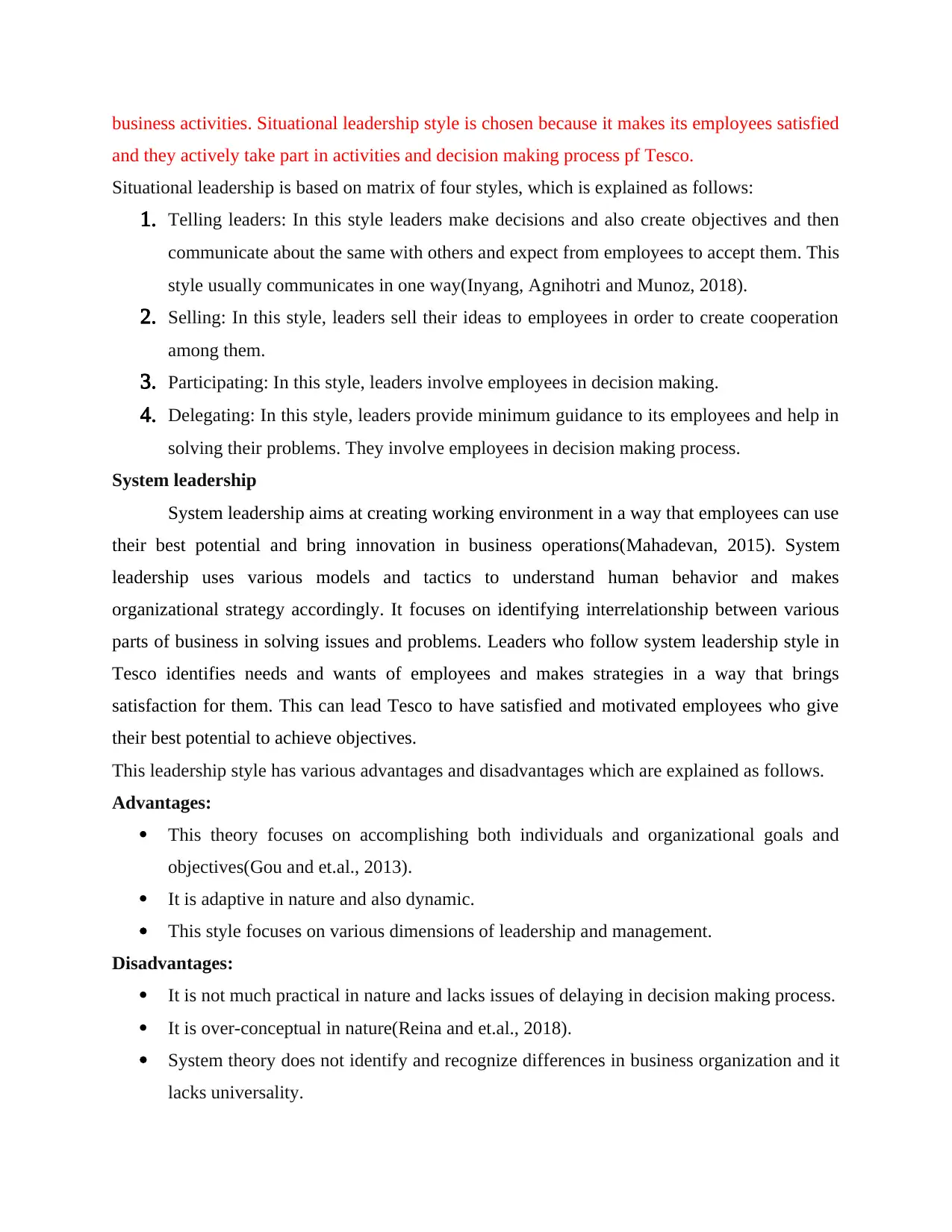
business activities. Situational leadership style is chosen because it makes its employees satisfied
and they actively take part in activities and decision making process pf Tesco.
Situational leadership is based on matrix of four styles, which is explained as follows:
1. Telling leaders: In this style leaders make decisions and also create objectives and then
communicate about the same with others and expect from employees to accept them. This
style usually communicates in one way(Inyang, Agnihotri and Munoz, 2018).
2. Selling: In this style, leaders sell their ideas to employees in order to create cooperation
among them.
3. Participating: In this style, leaders involve employees in decision making.
4. Delegating: In this style, leaders provide minimum guidance to its employees and help in
solving their problems. They involve employees in decision making process.
System leadership
System leadership aims at creating working environment in a way that employees can use
their best potential and bring innovation in business operations(Mahadevan, 2015). System
leadership uses various models and tactics to understand human behavior and makes
organizational strategy accordingly. It focuses on identifying interrelationship between various
parts of business in solving issues and problems. Leaders who follow system leadership style in
Tesco identifies needs and wants of employees and makes strategies in a way that brings
satisfaction for them. This can lead Tesco to have satisfied and motivated employees who give
their best potential to achieve objectives.
This leadership style has various advantages and disadvantages which are explained as follows.
Advantages:
This theory focuses on accomplishing both individuals and organizational goals and
objectives(Gou and et.al., 2013).
It is adaptive in nature and also dynamic.
This style focuses on various dimensions of leadership and management.
Disadvantages:
It is not much practical in nature and lacks issues of delaying in decision making process.
It is over-conceptual in nature(Reina and et.al., 2018).
System theory does not identify and recognize differences in business organization and it
lacks universality.
and they actively take part in activities and decision making process pf Tesco.
Situational leadership is based on matrix of four styles, which is explained as follows:
1. Telling leaders: In this style leaders make decisions and also create objectives and then
communicate about the same with others and expect from employees to accept them. This
style usually communicates in one way(Inyang, Agnihotri and Munoz, 2018).
2. Selling: In this style, leaders sell their ideas to employees in order to create cooperation
among them.
3. Participating: In this style, leaders involve employees in decision making.
4. Delegating: In this style, leaders provide minimum guidance to its employees and help in
solving their problems. They involve employees in decision making process.
System leadership
System leadership aims at creating working environment in a way that employees can use
their best potential and bring innovation in business operations(Mahadevan, 2015). System
leadership uses various models and tactics to understand human behavior and makes
organizational strategy accordingly. It focuses on identifying interrelationship between various
parts of business in solving issues and problems. Leaders who follow system leadership style in
Tesco identifies needs and wants of employees and makes strategies in a way that brings
satisfaction for them. This can lead Tesco to have satisfied and motivated employees who give
their best potential to achieve objectives.
This leadership style has various advantages and disadvantages which are explained as follows.
Advantages:
This theory focuses on accomplishing both individuals and organizational goals and
objectives(Gou and et.al., 2013).
It is adaptive in nature and also dynamic.
This style focuses on various dimensions of leadership and management.
Disadvantages:
It is not much practical in nature and lacks issues of delaying in decision making process.
It is over-conceptual in nature(Reina and et.al., 2018).
System theory does not identify and recognize differences in business organization and it
lacks universality.
Paraphrase This Document
Need a fresh take? Get an instant paraphrase of this document with our AI Paraphraser
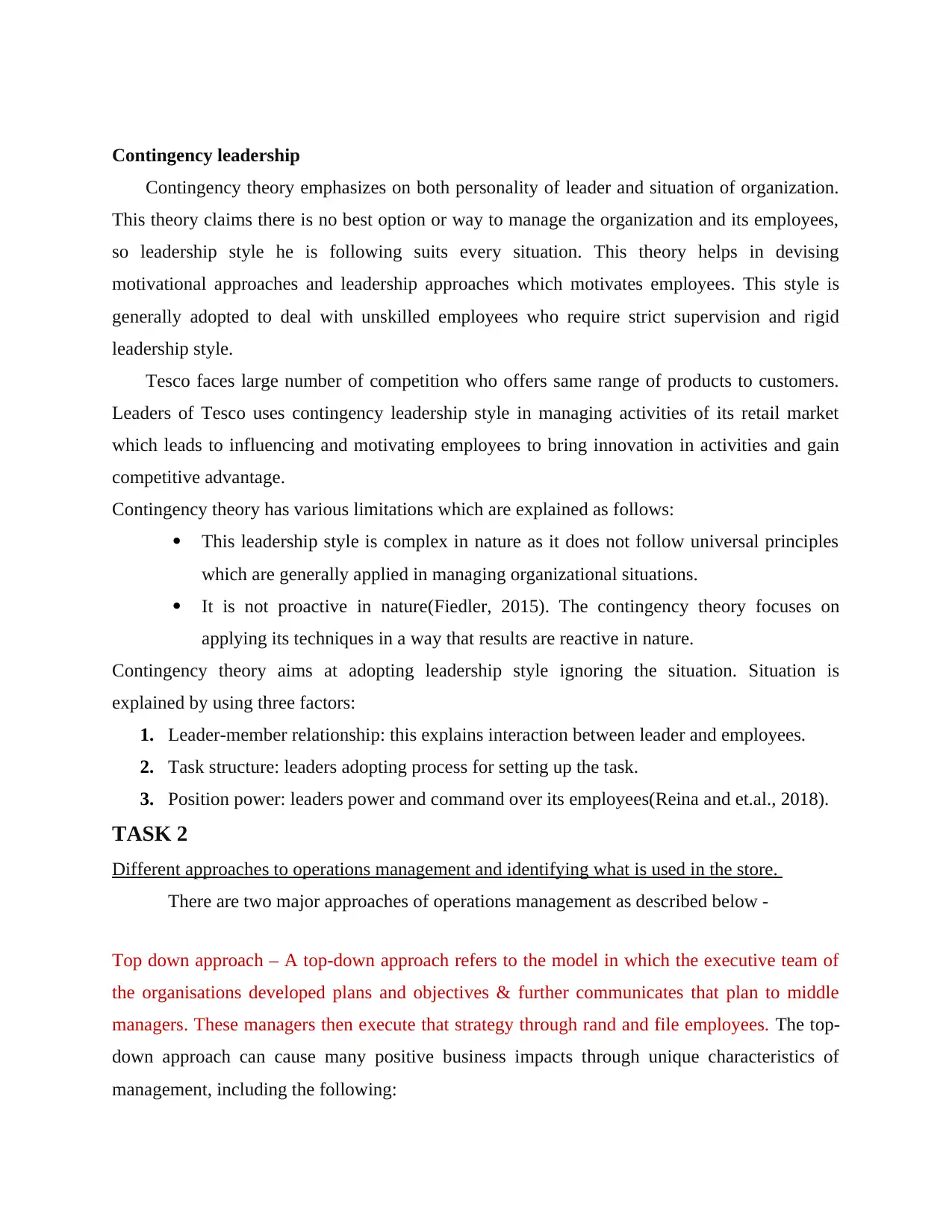
Contingency leadership
Contingency theory emphasizes on both personality of leader and situation of organization.
This theory claims there is no best option or way to manage the organization and its employees,
so leadership style he is following suits every situation. This theory helps in devising
motivational approaches and leadership approaches which motivates employees. This style is
generally adopted to deal with unskilled employees who require strict supervision and rigid
leadership style.
Tesco faces large number of competition who offers same range of products to customers.
Leaders of Tesco uses contingency leadership style in managing activities of its retail market
which leads to influencing and motivating employees to bring innovation in activities and gain
competitive advantage.
Contingency theory has various limitations which are explained as follows:
This leadership style is complex in nature as it does not follow universal principles
which are generally applied in managing organizational situations.
It is not proactive in nature(Fiedler, 2015). The contingency theory focuses on
applying its techniques in a way that results are reactive in nature.
Contingency theory aims at adopting leadership style ignoring the situation. Situation is
explained by using three factors:
1. Leader-member relationship: this explains interaction between leader and employees.
2. Task structure: leaders adopting process for setting up the task.
3. Position power: leaders power and command over its employees(Reina and et.al., 2018).
TASK 2
Different approaches to operations management and identifying what is used in the store.
There are two major approaches of operations management as described below -
Top down approach – A top-down approach refers to the model in which the executive team of
the organisations developed plans and objectives & further communicates that plan to middle
managers. These managers then execute that strategy through rand and file employees. The top-
down approach can cause many positive business impacts through unique characteristics of
management, including the following:
Contingency theory emphasizes on both personality of leader and situation of organization.
This theory claims there is no best option or way to manage the organization and its employees,
so leadership style he is following suits every situation. This theory helps in devising
motivational approaches and leadership approaches which motivates employees. This style is
generally adopted to deal with unskilled employees who require strict supervision and rigid
leadership style.
Tesco faces large number of competition who offers same range of products to customers.
Leaders of Tesco uses contingency leadership style in managing activities of its retail market
which leads to influencing and motivating employees to bring innovation in activities and gain
competitive advantage.
Contingency theory has various limitations which are explained as follows:
This leadership style is complex in nature as it does not follow universal principles
which are generally applied in managing organizational situations.
It is not proactive in nature(Fiedler, 2015). The contingency theory focuses on
applying its techniques in a way that results are reactive in nature.
Contingency theory aims at adopting leadership style ignoring the situation. Situation is
explained by using three factors:
1. Leader-member relationship: this explains interaction between leader and employees.
2. Task structure: leaders adopting process for setting up the task.
3. Position power: leaders power and command over its employees(Reina and et.al., 2018).
TASK 2
Different approaches to operations management and identifying what is used in the store.
There are two major approaches of operations management as described below -
Top down approach – A top-down approach refers to the model in which the executive team of
the organisations developed plans and objectives & further communicates that plan to middle
managers. These managers then execute that strategy through rand and file employees. The top-
down approach can cause many positive business impacts through unique characteristics of
management, including the following:
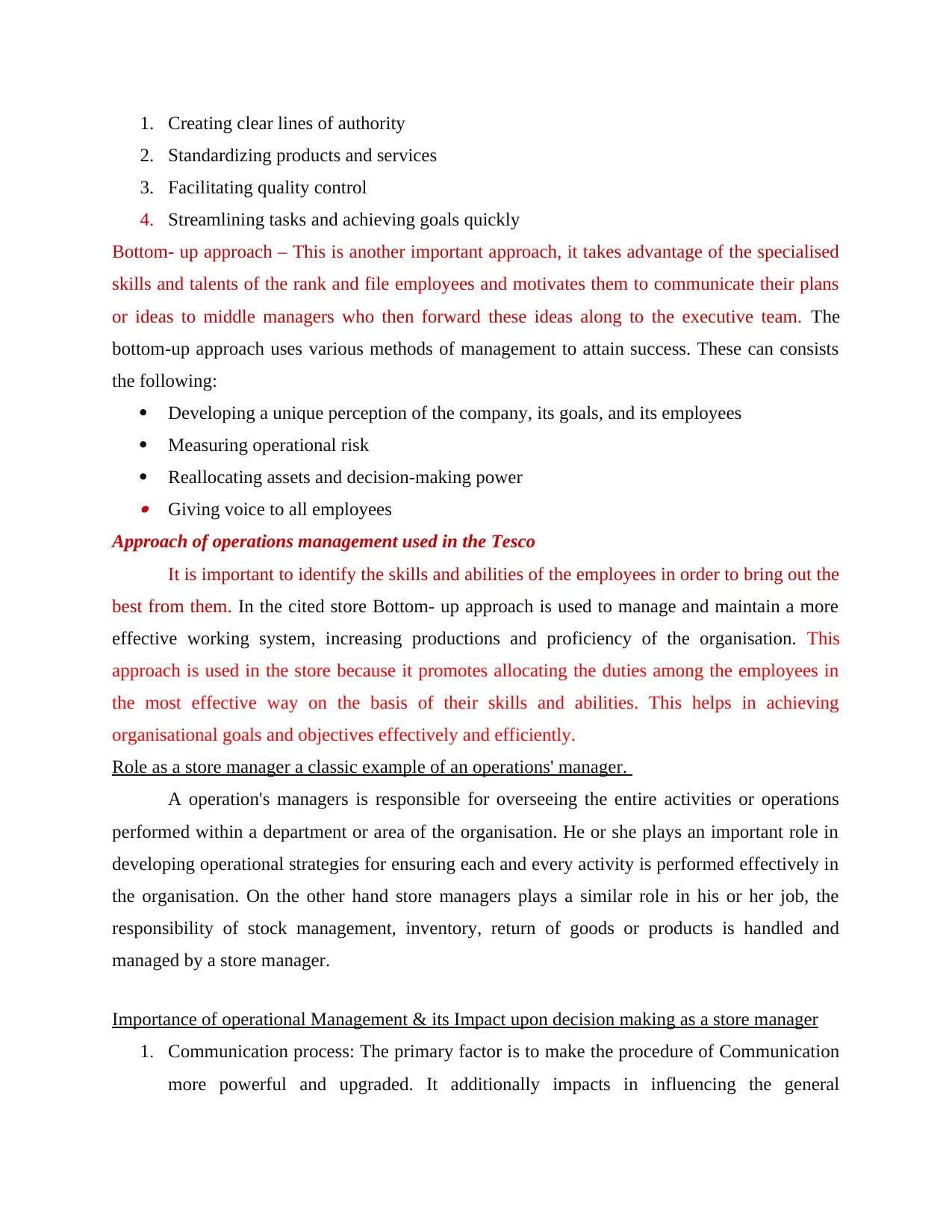
1. Creating clear lines of authority
2. Standardizing products and services
3. Facilitating quality control
4. Streamlining tasks and achieving goals quickly
Bottom- up approach – This is another important approach, it takes advantage of the specialised
skills and talents of the rank and file employees and motivates them to communicate their plans
or ideas to middle managers who then forward these ideas along to the executive team. The
bottom-up approach uses various methods of management to attain success. These can consists
the following:
Developing a unique perception of the company, its goals, and its employees
Measuring operational risk
Reallocating assets and decision-making power Giving voice to all employees
Approach of operations management used in the Tesco
It is important to identify the skills and abilities of the employees in order to bring out the
best from them. In the cited store Bottom- up approach is used to manage and maintain a more
effective working system, increasing productions and proficiency of the organisation. This
approach is used in the store because it promotes allocating the duties among the employees in
the most effective way on the basis of their skills and abilities. This helps in achieving
organisational goals and objectives effectively and efficiently.
Role as a store manager a classic example of an operations' manager.
A operation's managers is responsible for overseeing the entire activities or operations
performed within a department or area of the organisation. He or she plays an important role in
developing operational strategies for ensuring each and every activity is performed effectively in
the organisation. On the other hand store managers plays a similar role in his or her job, the
responsibility of stock management, inventory, return of goods or products is handled and
managed by a store manager.
Importance of operational Management & its Impact upon decision making as a store manager
1. Communication process: The primary factor is to make the procedure of Communication
more powerful and upgraded. It additionally impacts in influencing the general
2. Standardizing products and services
3. Facilitating quality control
4. Streamlining tasks and achieving goals quickly
Bottom- up approach – This is another important approach, it takes advantage of the specialised
skills and talents of the rank and file employees and motivates them to communicate their plans
or ideas to middle managers who then forward these ideas along to the executive team. The
bottom-up approach uses various methods of management to attain success. These can consists
the following:
Developing a unique perception of the company, its goals, and its employees
Measuring operational risk
Reallocating assets and decision-making power Giving voice to all employees
Approach of operations management used in the Tesco
It is important to identify the skills and abilities of the employees in order to bring out the
best from them. In the cited store Bottom- up approach is used to manage and maintain a more
effective working system, increasing productions and proficiency of the organisation. This
approach is used in the store because it promotes allocating the duties among the employees in
the most effective way on the basis of their skills and abilities. This helps in achieving
organisational goals and objectives effectively and efficiently.
Role as a store manager a classic example of an operations' manager.
A operation's managers is responsible for overseeing the entire activities or operations
performed within a department or area of the organisation. He or she plays an important role in
developing operational strategies for ensuring each and every activity is performed effectively in
the organisation. On the other hand store managers plays a similar role in his or her job, the
responsibility of stock management, inventory, return of goods or products is handled and
managed by a store manager.
Importance of operational Management & its Impact upon decision making as a store manager
1. Communication process: The primary factor is to make the procedure of Communication
more powerful and upgraded. It additionally impacts in influencing the general
⊘ This is a preview!⊘
Do you want full access?
Subscribe today to unlock all pages.

Trusted by 1+ million students worldwide
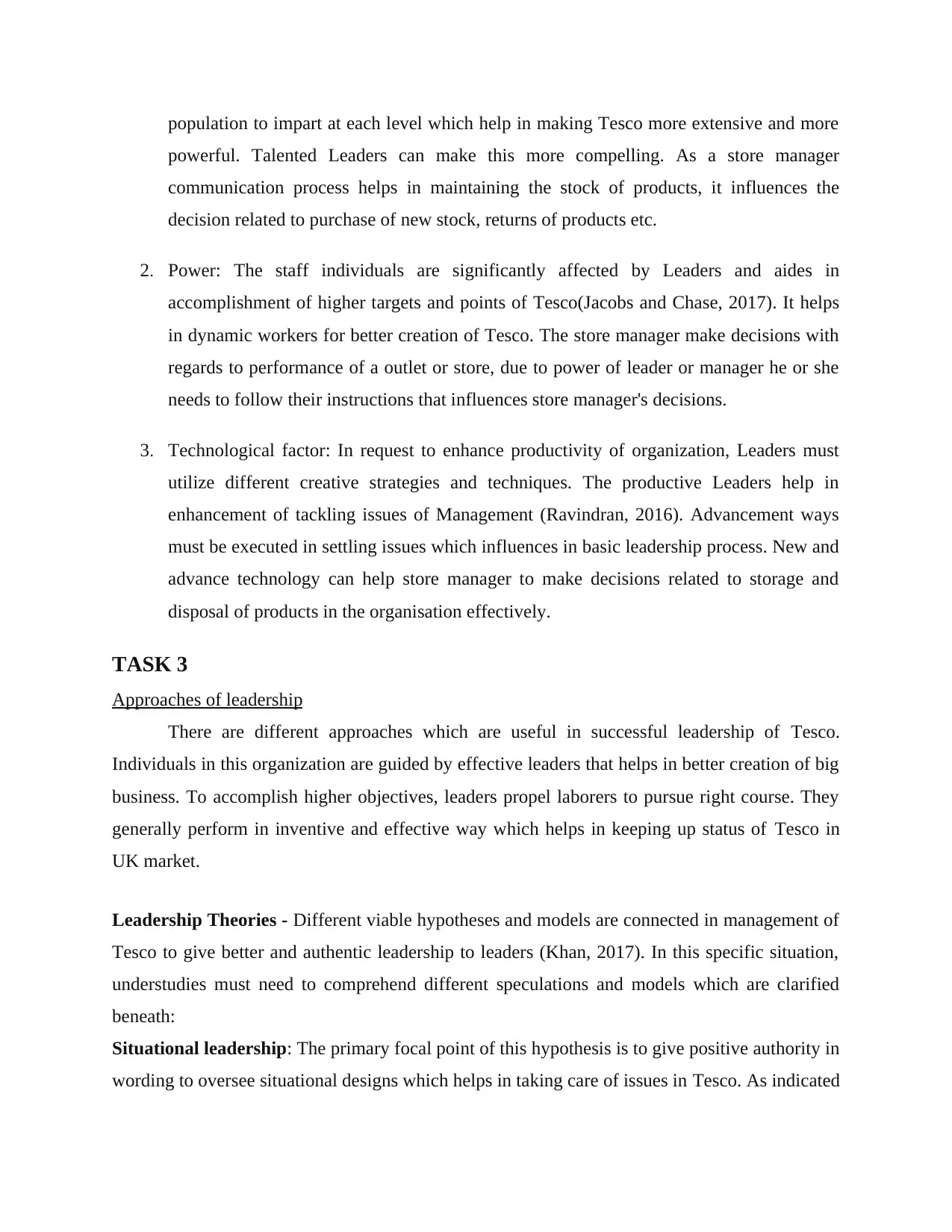
population to impart at each level which help in making Tesco more extensive and more
powerful. Talented Leaders can make this more compelling. As a store manager
communication process helps in maintaining the stock of products, it influences the
decision related to purchase of new stock, returns of products etc.
2. Power: The staff individuals are significantly affected by Leaders and aides in
accomplishment of higher targets and points of Tesco(Jacobs and Chase, 2017). It helps
in dynamic workers for better creation of Tesco. The store manager make decisions with
regards to performance of a outlet or store, due to power of leader or manager he or she
needs to follow their instructions that influences store manager's decisions.
3. Technological factor: In request to enhance productivity of organization, Leaders must
utilize different creative strategies and techniques. The productive Leaders help in
enhancement of tackling issues of Management (Ravindran, 2016). Advancement ways
must be executed in settling issues which influences in basic leadership process. New and
advance technology can help store manager to make decisions related to storage and
disposal of products in the organisation effectively.
TASK 3
Approaches of leadership
There are different approaches which are useful in successful leadership of Tesco.
Individuals in this organization are guided by effective leaders that helps in better creation of big
business. To accomplish higher objectives, leaders propel laborers to pursue right course. They
generally perform in inventive and effective way which helps in keeping up status of Tesco in
UK market.
Leadership Theories - Different viable hypotheses and models are connected in management of
Tesco to give better and authentic leadership to leaders (Khan, 2017). In this specific situation,
understudies must need to comprehend different speculations and models which are clarified
beneath:
Situational leadership: The primary focal point of this hypothesis is to give positive authority in
wording to oversee situational designs which helps in taking care of issues in Tesco. As indicated
powerful. Talented Leaders can make this more compelling. As a store manager
communication process helps in maintaining the stock of products, it influences the
decision related to purchase of new stock, returns of products etc.
2. Power: The staff individuals are significantly affected by Leaders and aides in
accomplishment of higher targets and points of Tesco(Jacobs and Chase, 2017). It helps
in dynamic workers for better creation of Tesco. The store manager make decisions with
regards to performance of a outlet or store, due to power of leader or manager he or she
needs to follow their instructions that influences store manager's decisions.
3. Technological factor: In request to enhance productivity of organization, Leaders must
utilize different creative strategies and techniques. The productive Leaders help in
enhancement of tackling issues of Management (Ravindran, 2016). Advancement ways
must be executed in settling issues which influences in basic leadership process. New and
advance technology can help store manager to make decisions related to storage and
disposal of products in the organisation effectively.
TASK 3
Approaches of leadership
There are different approaches which are useful in successful leadership of Tesco.
Individuals in this organization are guided by effective leaders that helps in better creation of big
business. To accomplish higher objectives, leaders propel laborers to pursue right course. They
generally perform in inventive and effective way which helps in keeping up status of Tesco in
UK market.
Leadership Theories - Different viable hypotheses and models are connected in management of
Tesco to give better and authentic leadership to leaders (Khan, 2017). In this specific situation,
understudies must need to comprehend different speculations and models which are clarified
beneath:
Situational leadership: The primary focal point of this hypothesis is to give positive authority in
wording to oversee situational designs which helps in taking care of issues in Tesco. As indicated
Paraphrase This Document
Need a fresh take? Get an instant paraphrase of this document with our AI Paraphraser
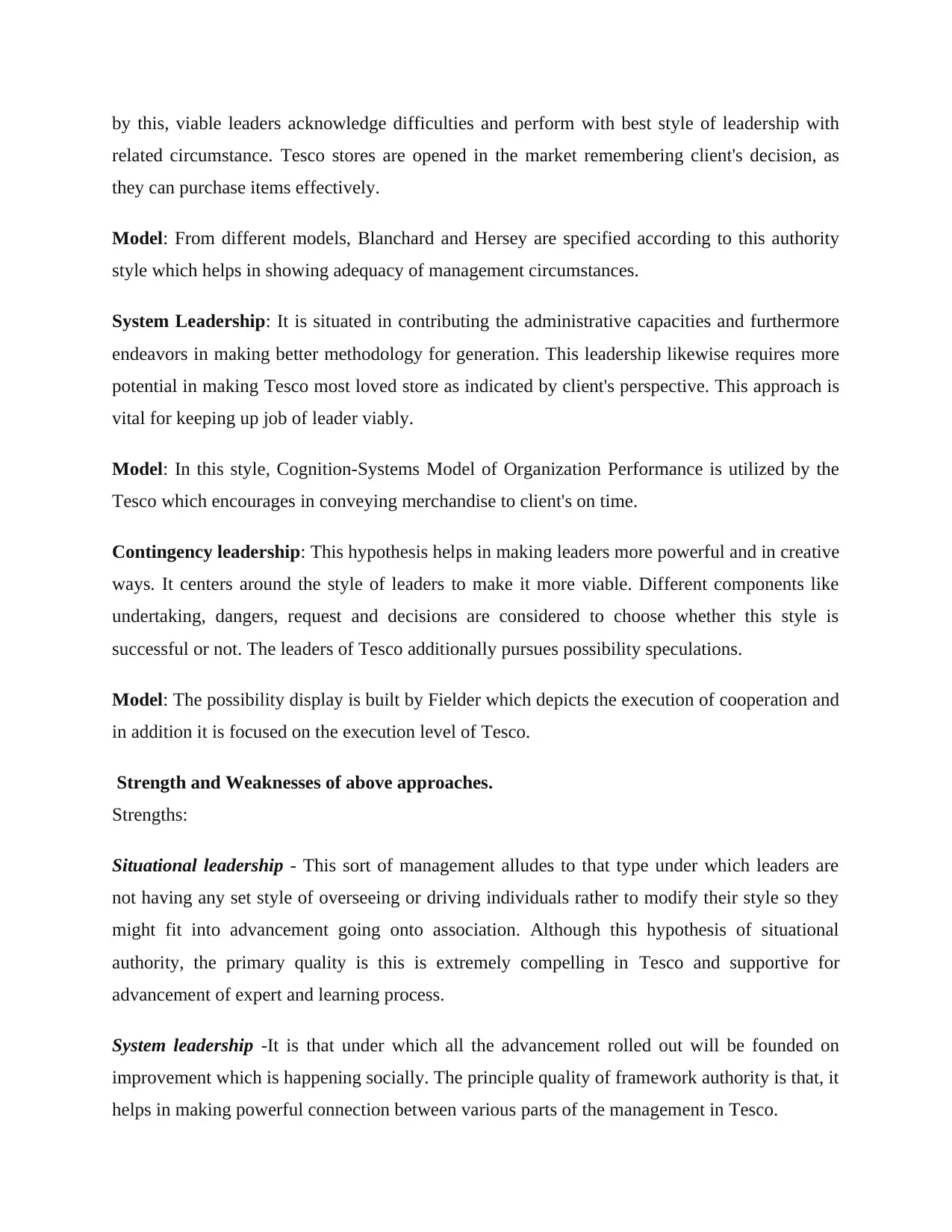
by this, viable leaders acknowledge difficulties and perform with best style of leadership with
related circumstance. Tesco stores are opened in the market remembering client's decision, as
they can purchase items effectively.
Model: From different models, Blanchard and Hersey are specified according to this authority
style which helps in showing adequacy of management circumstances.
System Leadership: It is situated in contributing the administrative capacities and furthermore
endeavors in making better methodology for generation. This leadership likewise requires more
potential in making Tesco most loved store as indicated by client's perspective. This approach is
vital for keeping up job of leader viably.
Model: In this style, Cognition-Systems Model of Organization Performance is utilized by the
Tesco which encourages in conveying merchandise to client's on time.
Contingency leadership: This hypothesis helps in making leaders more powerful and in creative
ways. It centers around the style of leaders to make it more viable. Different components like
undertaking, dangers, request and decisions are considered to choose whether this style is
successful or not. The leaders of Tesco additionally pursues possibility speculations.
Model: The possibility display is built by Fielder which depicts the execution of cooperation and
in addition it is focused on the execution level of Tesco.
Strength and Weaknesses of above approaches.
Strengths:
Situational leadership - This sort of management alludes to that type under which leaders are
not having any set style of overseeing or driving individuals rather to modify their style so they
might fit into advancement going onto association. Although this hypothesis of situational
authority, the primary quality is this is extremely compelling in Tesco and supportive for
advancement of expert and learning process.
System leadership -It is that under which all the advancement rolled out will be founded on
improvement which is happening socially. The principle quality of framework authority is that, it
helps in making powerful connection between various parts of the management in Tesco.
related circumstance. Tesco stores are opened in the market remembering client's decision, as
they can purchase items effectively.
Model: From different models, Blanchard and Hersey are specified according to this authority
style which helps in showing adequacy of management circumstances.
System Leadership: It is situated in contributing the administrative capacities and furthermore
endeavors in making better methodology for generation. This leadership likewise requires more
potential in making Tesco most loved store as indicated by client's perspective. This approach is
vital for keeping up job of leader viably.
Model: In this style, Cognition-Systems Model of Organization Performance is utilized by the
Tesco which encourages in conveying merchandise to client's on time.
Contingency leadership: This hypothesis helps in making leaders more powerful and in creative
ways. It centers around the style of leaders to make it more viable. Different components like
undertaking, dangers, request and decisions are considered to choose whether this style is
successful or not. The leaders of Tesco additionally pursues possibility speculations.
Model: The possibility display is built by Fielder which depicts the execution of cooperation and
in addition it is focused on the execution level of Tesco.
Strength and Weaknesses of above approaches.
Strengths:
Situational leadership - This sort of management alludes to that type under which leaders are
not having any set style of overseeing or driving individuals rather to modify their style so they
might fit into advancement going onto association. Although this hypothesis of situational
authority, the primary quality is this is extremely compelling in Tesco and supportive for
advancement of expert and learning process.
System leadership -It is that under which all the advancement rolled out will be founded on
improvement which is happening socially. The principle quality of framework authority is that, it
helps in making powerful connection between various parts of the management in Tesco.
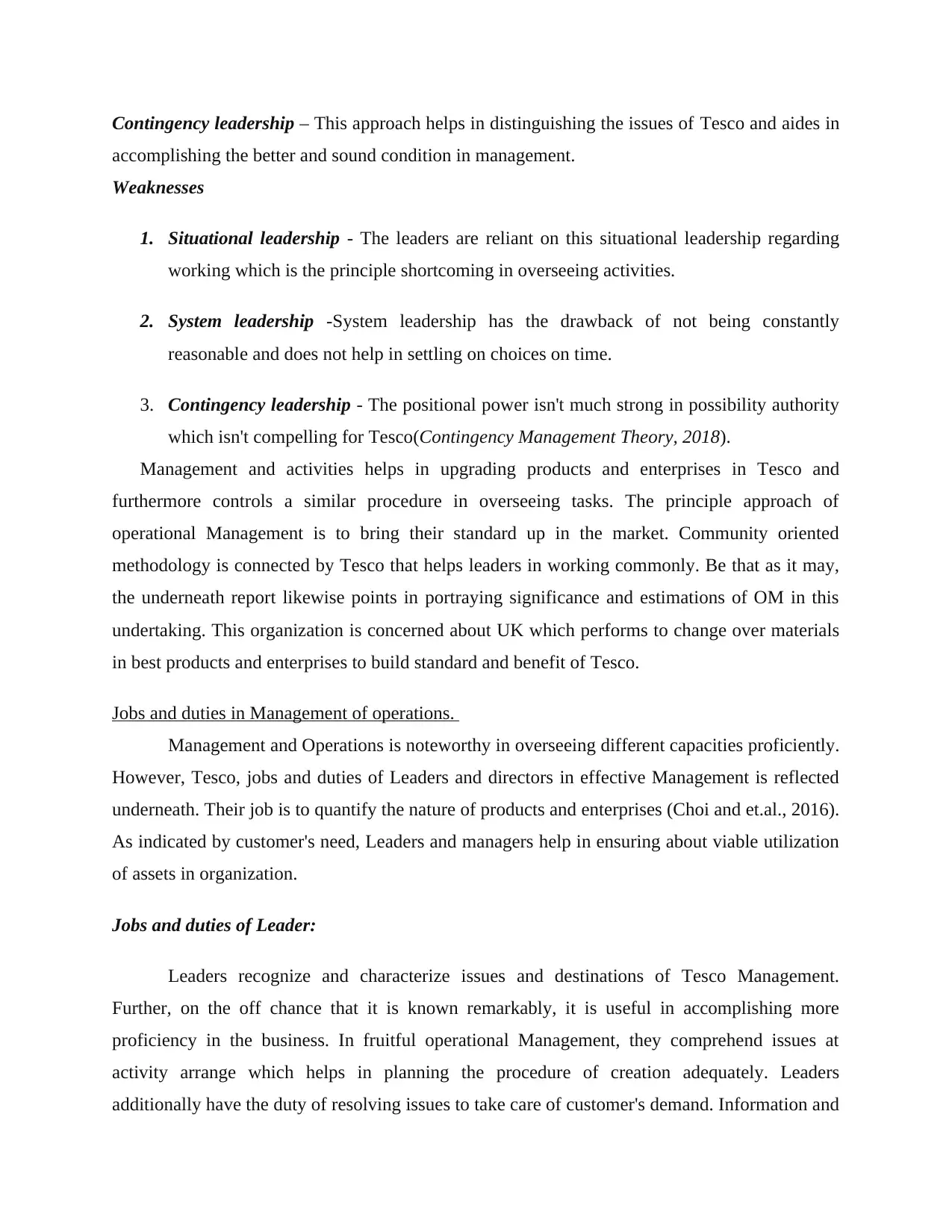
Contingency leadership – This approach helps in distinguishing the issues of Tesco and aides in
accomplishing the better and sound condition in management.
Weaknesses
1. Situational leadership - The leaders are reliant on this situational leadership regarding
working which is the principle shortcoming in overseeing activities.
2. System leadership -System leadership has the drawback of not being constantly
reasonable and does not help in settling on choices on time.
3. Contingency leadership - The positional power isn't much strong in possibility authority
which isn't compelling for Tesco(Contingency Management Theory, 2018).
Management and activities helps in upgrading products and enterprises in Tesco and
furthermore controls a similar procedure in overseeing tasks. The principle approach of
operational Management is to bring their standard up in the market. Community oriented
methodology is connected by Tesco that helps leaders in working commonly. Be that as it may,
the underneath report likewise points in portraying significance and estimations of OM in this
undertaking. This organization is concerned about UK which performs to change over materials
in best products and enterprises to build standard and benefit of Tesco.
Jobs and duties in Management of operations.
Management and Operations is noteworthy in overseeing different capacities proficiently.
However, Tesco, jobs and duties of Leaders and directors in effective Management is reflected
underneath. Their job is to quantify the nature of products and enterprises (Choi and et.al., 2016).
As indicated by customer's need, Leaders and managers help in ensuring about viable utilization
of assets in organization.
Jobs and duties of Leader:
Leaders recognize and characterize issues and destinations of Tesco Management.
Further, on the off chance that it is known remarkably, it is useful in accomplishing more
proficiency in the business. In fruitful operational Management, they comprehend issues at
activity arrange which helps in planning the procedure of creation adequately. Leaders
additionally have the duty of resolving issues to take care of customer's demand. Information and
accomplishing the better and sound condition in management.
Weaknesses
1. Situational leadership - The leaders are reliant on this situational leadership regarding
working which is the principle shortcoming in overseeing activities.
2. System leadership -System leadership has the drawback of not being constantly
reasonable and does not help in settling on choices on time.
3. Contingency leadership - The positional power isn't much strong in possibility authority
which isn't compelling for Tesco(Contingency Management Theory, 2018).
Management and activities helps in upgrading products and enterprises in Tesco and
furthermore controls a similar procedure in overseeing tasks. The principle approach of
operational Management is to bring their standard up in the market. Community oriented
methodology is connected by Tesco that helps leaders in working commonly. Be that as it may,
the underneath report likewise points in portraying significance and estimations of OM in this
undertaking. This organization is concerned about UK which performs to change over materials
in best products and enterprises to build standard and benefit of Tesco.
Jobs and duties in Management of operations.
Management and Operations is noteworthy in overseeing different capacities proficiently.
However, Tesco, jobs and duties of Leaders and directors in effective Management is reflected
underneath. Their job is to quantify the nature of products and enterprises (Choi and et.al., 2016).
As indicated by customer's need, Leaders and managers help in ensuring about viable utilization
of assets in organization.
Jobs and duties of Leader:
Leaders recognize and characterize issues and destinations of Tesco Management.
Further, on the off chance that it is known remarkably, it is useful in accomplishing more
proficiency in the business. In fruitful operational Management, they comprehend issues at
activity arrange which helps in planning the procedure of creation adequately. Leaders
additionally have the duty of resolving issues to take care of customer's demand. Information and
⊘ This is a preview!⊘
Do you want full access?
Subscribe today to unlock all pages.

Trusted by 1+ million students worldwide
1 out of 18
Related Documents
Your All-in-One AI-Powered Toolkit for Academic Success.
+13062052269
info@desklib.com
Available 24*7 on WhatsApp / Email
![[object Object]](/_next/static/media/star-bottom.7253800d.svg)
Unlock your academic potential
Copyright © 2020–2025 A2Z Services. All Rights Reserved. Developed and managed by ZUCOL.





